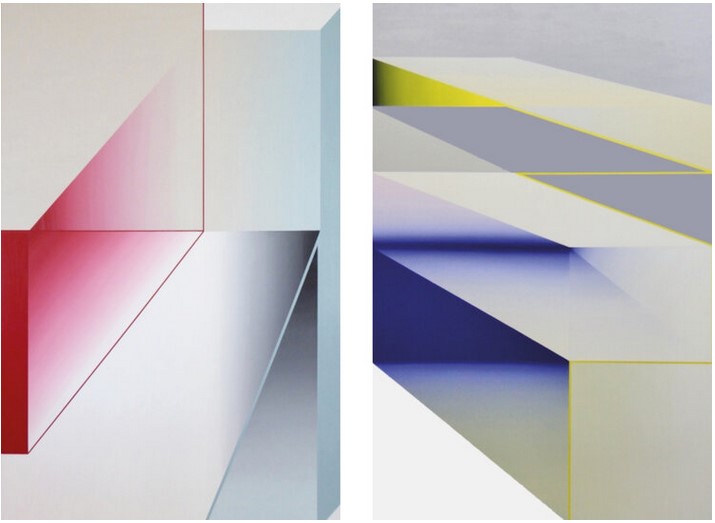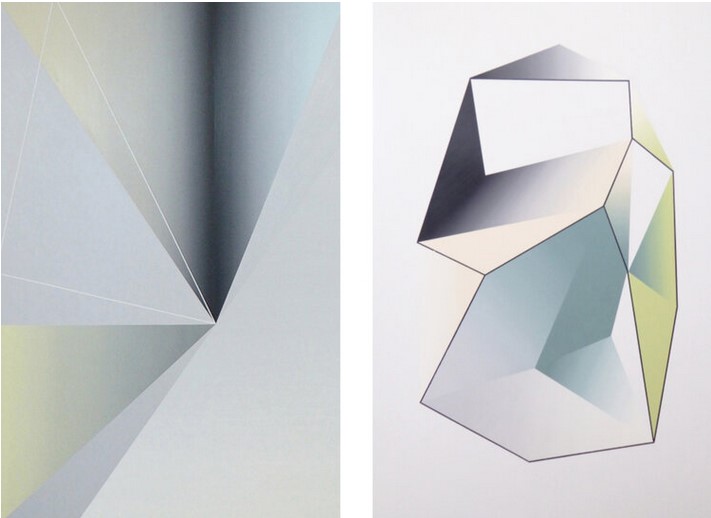PATO PAEZ, ART-IOLOGIST: A SCIENTIFIC APPROACH TO ART CRITICISM.
GABI MITTERER’S WORK
For the last few months, I’ve been obsessed with the work of Austrian artist Gabi Mitterer. I first saw images of it on Instagram, and last summer had the chance to see a couple of pieces at the Davidson Gallery. Seeing Gabi’s art in person ignited an even bigger excitement for the work that she produces.
Mitterer has created a body of work that, in my eyes, falls somewhere between figurativeness and abstraction. Though the work does not attempt to represent an external reality, my brain can’t help but compare the lines and shapes she depicts with objects from Donald Judd’s work. Her work inspires the same elements of minimalist visual culture that characterizes Judd’s, but after the initial comparison, it’s clear that Mitterer’s also takes on a life of its own.
 My favorite part of her oeuvre is the collection “Roofoli”. The collection is represented by oil paintings on canvas, of roughly 60”h x 48”w. These pieces have depth… lots of it.
My favorite part of her oeuvre is the collection “Roofoli”. The collection is represented by oil paintings on canvas, of roughly 60”h x 48”w. These pieces have depth… lots of it.
Visual perception has evolved to give us an understanding of the world around us. We call it perception because it’s how our brains make sense of our environment and, with our experience, have created rules that allow us to move about the world successfully.
In these works, Mitterer uses a simple palette with a variety of desaturated colors. The presence of one highly saturated color creates a focal point that immediately draws the eye to that area of the canvas. This emphasis in color demands the most immediate attention to the work.

Gradual shading creates the illusion of depth by elucidating the perception of luminance variation, thereby adding to the three-dimensionality of the work. Along with the depiction of rectilinear objects, the difference in value of the same color becomes the key element in 3D perception, making the hollowness of the featured objects apparent. Lastly, converging lines add to the perception of depth, distance and length of these objects, turning the elements of the work into three-dimensional concave and convex objects, which my brain simplifies as stacked construction materials. The straight lines that constitute the borders of the objects portrayed are of a contrasting color with the colors that they contain—sometimes lighter, sometimes darker—creating a sense of definition.
Lines and shading create the illusion that objects extend beyond the boundaries of the panel, which causes our curiosity to kick in and keeps us wondering what exists beyond the limits of what’s in front of us. Converging lines are a clue that the brain takes to compute distance, which falls beyond the edges of the panel, creating a sense of curiosity over how these objects might exist outside the tangible elements that define them. To satisfy the desire to understand what we’re seeing, the work keeps us engaged. This is the thing about abstraction: it incites curiosity at a very primal level, eliciting a pure emotional response to the work that’s orchestrated by the top-down processing systems of the brain. This is one of the two processes of perception in our brains. Top-down processing uses memories and emotions to assign meaning to what’s in front of us. Based on our life experiences, our interpretation of abstract work will vary, making it a truly distinctive understanding of what we’re seeing. At its core, this is the basis for individuality.
In a world that is chaotic and unpredictable, our brains try to simplify and make sense of what we’re seeing---or at least that’s what evolutionary psychology proposes.
By challenging our brains with abstraction, Mitterer’s work engages high level areas of cognition and prompts us to try to understand what we’re seeing. Mitterer does a good job of setting it free for the viewer to decide. It isn’t up to the artist to decide what our understanding of the message is. For the most part, we all seem to perceive the input similarly, and can describe what we’re seeing accurately. However, the emotional effect that the work has on the viewer is at the core of individuality, and it must honored.
Pato Paez, Co-founder of The Commission Project.
Pato’s background in science cultivated his focus on the psychological effect of art, chiefly the way humans respond to its various elements including color, style, content, and structure.